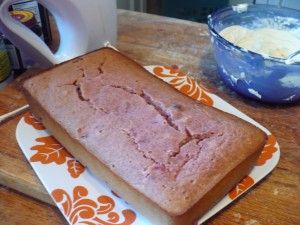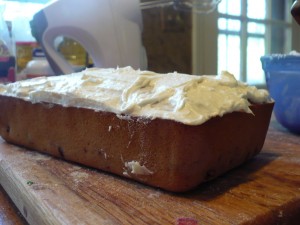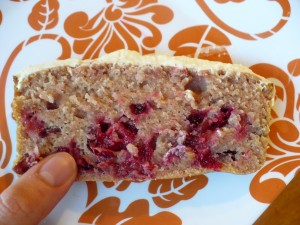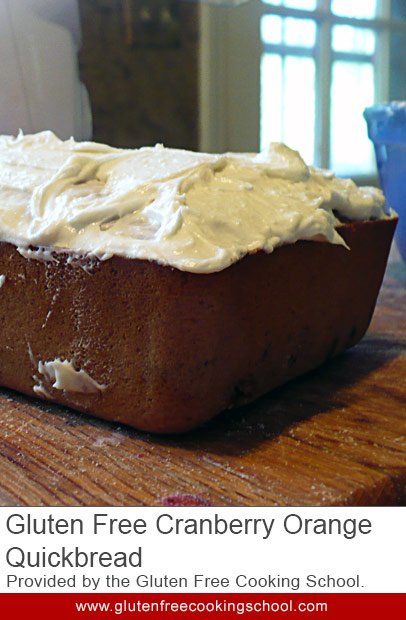In my last post I mentioned that I was going to experiment with gluten free ratios and start weighing out my recipes. To hold myself accountable (because we all see how well I’ve done with posting my bread experiments) I decided to join the Gluten Free Ratio Rally that Shauna Ahern of Gluten Free Girl started last month.
The Rally experiment for this month was quickbread. The challenge was to make a gluten free quickbread using the ratio specified in Michael Ruhlman’s book, Ratio: The Simple Codes Behind the Craft of Everyday Cooking.
Silvana of Silvana’s Kitchen and author of Cooking for Isaiah is hosting the Gluten Free Ratio Rally Roundup, so go by her site to see the full list (and links) of everyone who participated.
The ratio for quickbread is 2 parts flour, 2 parts liquid, 1 part egg, and 1 part butter. Since I was late getting signed up for this month’s challenge I didn’t have the benefit of reading about the other bloggers’ experiments and using the community spreadsheet to work on my recipe calculations. I just started with the formula, said a prayer**, and then started working out the recipe amounts. Here’s a step-by-step analysis of how I came up with the final recipe.
First I considered the flour. This is where normal baking ratios get tricky for those of us who are doing gluten free baking. For the ratio (and the recipe) to work then your flour mix needs to act like the wheat flour does. And how the wheat flour acts differs depending on the type of recipe. For example, if you’re making bread then you want the gluten in the wheat flour to develop and create the structure for the loaf of bread. However, if you’re making quickbread or muffins, then you do not want the gluten to activate because that will make the bread/muffin tough.
The flour mix that I usually use has not fared well in my sandwich bread ratio experiments thus far. It seems to be much more absorbent than wheat flour in bread recipes, requiring far more liquids than is called for in the bread ratio. However, I’ve also used that flour recipes to successfully convert other baked goods recipes on a 1:1 basis. I only had one shot at getting this recipe right due to the Rally deadline, so rather than play with new flours I decided to use Mary’s Gluten Free All Purpose Flour Mix without any added xanthan gum. I did substitute coconut flour for the masa harina because I like to use coconut flour in sweet baked goods. Coconut flour and masa harina are both very absorbent, so doing a 1:1 substitution is fine.

With that decided I looked through my pantry, freezer, and refrigerator for some inspiration for the flavor of the quickbread. Two bags of whole cranberries have been hanging out in my freezer since November. Everytime I see them I think, “I should use those for something.” and then I close the door and go about whatever I was doing and the cranberries continue to sit. Enough with that. The time had come to make a cranberry flavored quick bread.
Most baked recipes use dried cranberries, rather than whole uncooked cranberries. I knew the flavor would be tart, but I was okay with that since I planned on topping the bread with a cream cheese icing. I also knew that cranberries contain pectin (pectin is what makes jam (n.) jam (v.), and that the pectin would keep the bread from being crumbly. The pectin was my insurance policy against a crumbly mess, since I had planned on not using any gums, or ground flax seeds for this recipe.
Deciding on Amounts
Finally I needed to decide how much of each ingredient should be in the recipe. I looked at a few quickbread recipes online and they all had around 2 c. of flour. I know that my flour mix weighs 4.5 oz. when I measure it out, so I started with 9.0 oz of flour. (Since my flour mix is a 9 part ratio, this also meant that I could pour the flours directly into the bowl, measuring them by weight, and not have to make up a batch of flour mix).
The quickbread ratio is 2 parts flour, 2 parts liquid, 1 part egg, and 1 part butter. Since I had chosen 9 oz of flour, I also needed 9 oz. of liquids, 4.5 oz of egg and 4.5 oz of butter. For the liquids I went with the juice of one orange, which ended up being 3 oz and 6 oz. of water.
Large eggs are supposed to weigh 2 oz. (and so one would usually start figuring out amounts by deciding how many whole eggs you want in your recipe), but all of the eggs that I have weighed have been less than that. I cracked 3 eggs into a bowl set on my digital scale and them removed one yolk and some whites until the weight was down to 4.5 oz. I ended up using the leftover egg for another recipe later that day.
A stick of butter weighs about 4.0 oz, so I used one stick of butter and 0.5 oz. of canola oil.

Now that I had decided on the main components of the recipe, I filled in the amounts of salt and baking powder from the standard recipe in Ruhlman’s book. I added a bit of vanilla and orange extract and baking soda because it seemed like the right thing to do. The amount of sugar for the recipe is not addressed by the ratio as you are supposed to alter it based on how sweet you want the bread to be and the tartness of your other ingredients. I knew that I’d need a good bit of sugar to balance the tartness of the cranberries, but I wasn’t sure how much. I checked the back of the bag of cranberries and used the amount (1 c.) recommended for cranberry relish. With that my recipe was complete, and it was time to bake it and see what happened.

As you can see from the pictures, the bread turned out really well. It was tart as expected, but I thought that was a perfect excuse to pile on more icing. The natural pectin in the cranberries did a great job of holding the bread together – very moist and dense which is how I like quickbread. John, who is not a huge fan of cranberries, ate a whole slice without stopping to even put it on a plate.
Recipes are rarely done after one attempt, and this recipe is not “finished”. Next time I’ll reduce the amount of cranberries and increase the sugar. The bread itself did not taste sweet and I think that there should be at least a hint of sweetness. I’ll also increase the amount of orange extract in the bread and icing, and top the icing with a few sprinkles of orange zest. This is going to make a very nice holiday bread after a few more tweaks.
**For many years I questioned the usefulness of prayer. I never doubted that my prayers were heard, but I never felt like I received any answers. The problem turned out to be that I wasn’t listening and looking for answers. Over the past few years I’ve realized that God often answers my prayers by giving me an idea that I wouldn’t have otherwise had.
For example, before I started this bread I asked God to help me write a good recipe because I knew that I’d only have time to bake one loaf this weekend. Then at key points while I was writing the recipe I mentally stopped to listen. When I was feeling uneasy about the flour mix, I remembered the cranberries and how they release pectin when you boil them. When I felt uneasy about whether the amount of liquids needed to be adjusted after I boiled the cranberries, I remembered that I could just weigh the liquid and make sure that it was the right amount. These may seem like obvious steps to take, but I promise you that before I stopped to mentally listen for a thought from God I was completely frustrated and unsure. Then He gave me an insight and I was able to go on confidently.
God answers my prayers like this all the time. Sometimes the answer is a thought. Sometimes it’s a Bible verse that I am able to understand in a new say. And the more that we live by faith and depend on God (not our own efforts) for our daily bread, the more we’re able to see him answering prayer through physical means.**
Instructions
- 3 oz. brown rice flour
- 3 oz. corn starch
- 2 oz. sorghum flour
- 1 oz. coconut flour
- 1 tsp. salt
- 2 tsp. baking powder
- 1/4 tsp. baking soda
- 4.0 oz. unsalted butter
- 3 oz. orange juice
- 6 oz. water
- 7.5 oz. sugar
- 12.0 oz. whole cranberries
- 4.5 oz. egg
- 0.5 oz. canola oil
- 1 tsp. vanilla extract
- 1/4 tsp. orange extract
Instructions:
- Measure the water, orange juice, sugar and cranberries into a small saucepan and bring to a boil. Stir until sugar is dissolved and then reduce heat to bring the mixture down to a simmer. Simmer until the berries began to pop – 10 to 12 minutes. Set the berry mixture aside to start cooling.
- Measure the flours, baking powder, baking soda, and salt and mix thoroughly with a fork. Cut the butter into the flour mixture until the butter lumps are the size of peas.
- Measure out 4.5 oz of egg. A large egg is supposed to weight about 2 oz. I used 3 eggs and then removed a yolk and some whites to bring the weight down to 4.5 oz. Whisk the eggs until no whites are obvious. Add the oil (approximately 1 Tbsp) and extracts and mix again.
- Pour the cranberry mixture (still pretty warm) into the flour mixture. While whisking the eggs add a small amount (2 – 3 Tbsp) of the batter to the eggs to temper them. Repeat this twice and then add the eggs into the batter. Stir thoroughly.
- Grease a loaf pan. Pour the batter into the loaf pan and bake the bread at 350 degrees F for 50Â minutes. The bread should have slightly browned around the edges and the loaf top will be spring back when touched.
